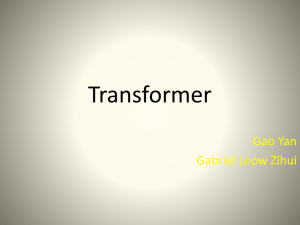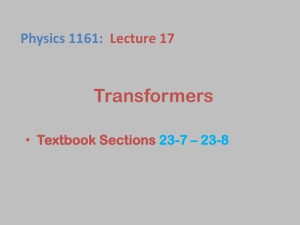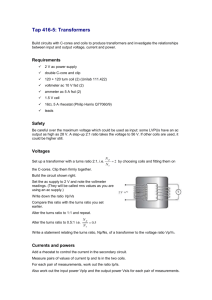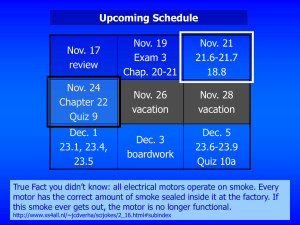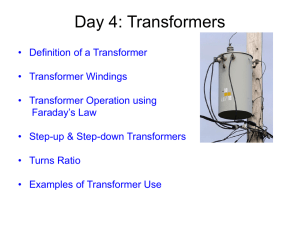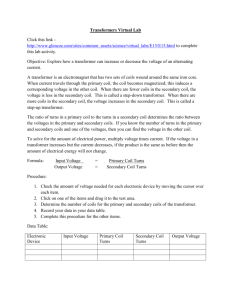Transformers Purpose of the experiment
advertisement
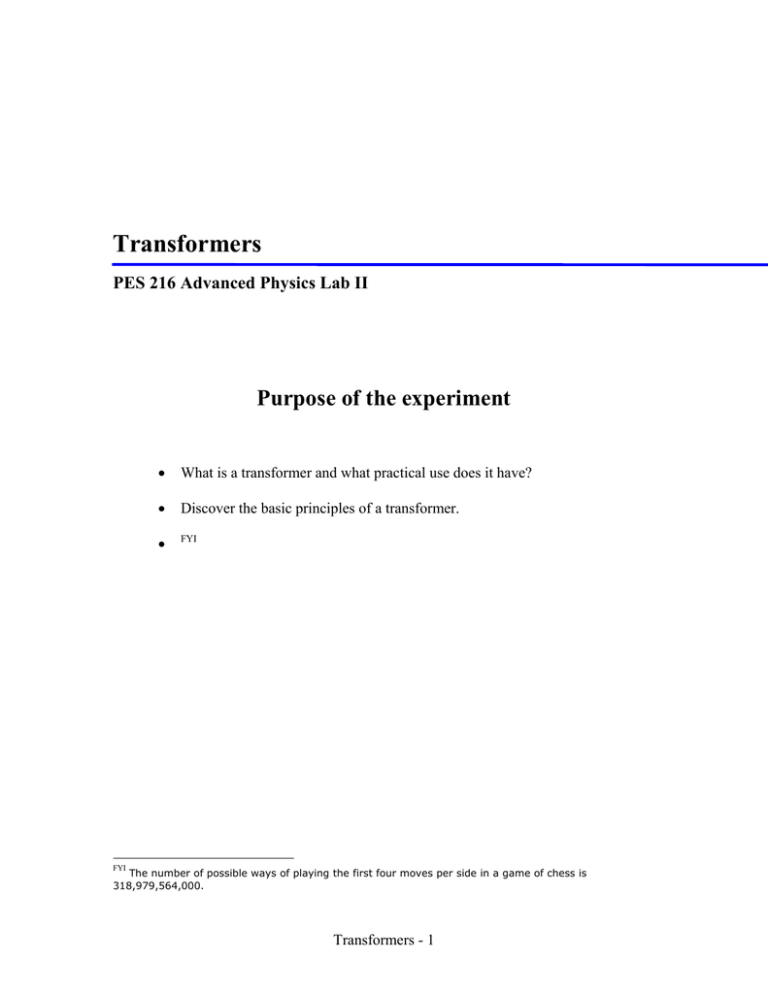
Transformers PES 216 Advanced Physics Lab II Purpose of the experiment • What is a transformer and what practical use does it have? • Discover the basic principles of a transformer. • FYI FYI The number of possible ways of playing the first four moves per side in a game of chess is 318,979,564,000. Transformers - 1 Table of Contents Background 3 Lab Procedure 5 Equipment List Banana cables Pasco Basic Coil Set Variable AC Power Supply Digital Multi-meter Transformers - 2 Background Transformer A transformer is a device that transfers energy from one electrical circuit to another by magnetic coupling. A transformer comprises of at least two coupled windings, and usually a magnetic core to concentrate magnetic flux. A voltage applied to one winding creates a timevarying magnetic flux in the core, which induces a voltage in the other windings. Varying Three-phase pole-mounted stepdown transformer. the relative number of turns in the windings determines the ratio of their voltages, thus transforming the voltage from one circuit to another. The transformer principle was demonstrated in 1831 by Faraday, though practical designs did not appear until the 1880s. Within less than a decade, the transformer was instrumental during the "War of Currents" in seeing alternating current systems triumph over their direct current counterparts, a position that has remained dominant. The transformer permits the economic transmission of power over long distances. Amongst the simplest of electrical machines, the transformer is also one of the most efficient, with large units attaining effiencies of 99.75%. Transformers come in a range of sizes from a thumbnail-sized coupling transformer hidden inside a stage microphone to huge gigawattrated units used to interconnect portions of national power grids. All operate with the same basic principles. Transformers - 3 Basic principles: Coupling by mutual induction To help understand the basic principles of the transformer let’s look at the ideal case. The hypothetical ideal transformer consists of two windings of zero resistance around a core of negligible reluctance (no loss of magnetic energy). A voltage applied to the primary An ideal step-down transformer showing magnetic flux in the core winding causes a current, which develops a magnetomotive force (MMF) in the core. The current required to create the MMF is termed the magnetising current; in the ideal transformer it is considered to be negligible. The MMF drives flux around the the core. An electromotive force (EMF) is induced across each winding, an effect known as mutual inductance. The windings in the ideal transformer have no resistance and so the EMFs are equal in magnitude to the measured terminal voltages. In accordance with Faraday's law of induction, they are proportional to the rate of change of flux: and where: and and and are the induced EMFs across primary and secondary windings, are the numbers of turns in the primary and secondary windings, are the time derivatives of the flux linking the primary and secondary windings. Transformers - 4 In the ideal transformer, all flux produced by the primary winding also links the secondary, and so , from which the well-known transformer equation follows: The ratio of primary to secondary voltage is therefore the same as the ratio of the number of turns. Procedure The following is a picture of the experimental setup: AC volt meter Iron Core Primary Coil Secondary Coil AC power supply Figure 1: Experimental Setup Transformers - 5 Part A: Transformer Basics 1. Set up the coils and core as shown in Figure 1. Typically the coil to which the input voltage is applied is referred to as the Primary Coil and the coil which supplies the output voltage is the Secondary Coil. Use a 400-turn coil as the primary and the other 400-turn coil as the secondary. To attach coils within the iron core loosen the bolt on the core until the iron cross bar can be removed. 2. Connect the AC power supply to the primary and adjust the input voltage to 6 volts ac, using the meter to monitor the voltage. Note: make sure the meter is setup to read AC volts. The frequency is not critical 100 Hz (the default value displayed on the AC supply when first turned on) will be fine. 3. Now that the input voltage has been set move the AC volt meter to the secondary coil. Measure the ac output voltage and record your results in Table 1. 4. Turn off the ac power supply and replace the 400-turn secondary with the 200-turn coil. Measure the ac output voltage and record your results in Table 1. 5. Repeat step (3) with the 800-turn coil as the secondary. 6. Calculate the Turns Ratio and ac voltage ratio in Table 1. Primary Turns, N p Secondary Turns, N s Turns Ratio N /N s p Primary ac Voltage, V p 400 400 400 • Secondary ac Voltage, V s ac Voltage Ratio, V /V s p 200 400 800 What does Table 1 indicate about the relationship between the ac Voltage Ratio and the Turns Ratio? Transformers - 6 • Using Graphical Analysis, make a graph of the V /V (on y-axis) vs N / N (on xs p s p axis). • Generate a best-fit straight line which fits your data. The slope of this graph for an “Ideal Transformer” should be 1. How close to ideal did you come? • Calculate the percent difference between your transformer and the ideal case. What could have caused the discrepancy? Part B: Effect of Transformer Cores Now that we have seen how a transform works let’s now examine how the induction between the coils is depended on the material and shape of the core. 1. Using air as the medium between the two coils, place two 400-turn coil face-to-face as shown in the diagram below. Apply the same 6 VAC to the primary coil and measure the voltage output on the secondary coil. 2. To improve the mutual induction, an iron core can be introduced to focus the magnetic field into the secondary coil. Using the cross piece from the U-shaped core, the induced voltage is increased. Measure this increase using the same setup as above. Transformers - 7 3. Numerous modifications of the cores can be investigated. In each case record the ratio of secondary voltage to primary voltage. 4. In the above experiments the input voltage and the number of coil turns where held constant and the configuration of the core was changed. Explain the outcome of each case, include the ratio of secondary voltage to primary voltage as evidence of your conclusions. Transformers - 8
